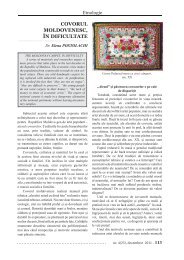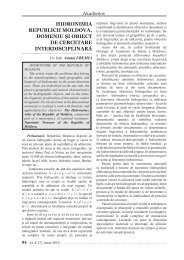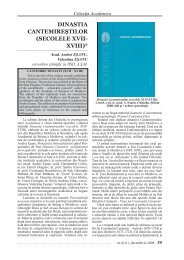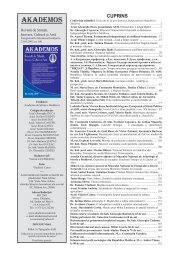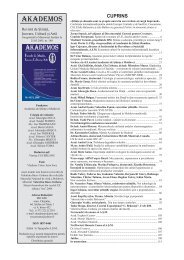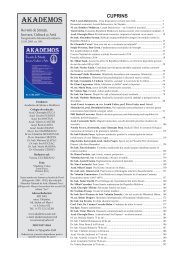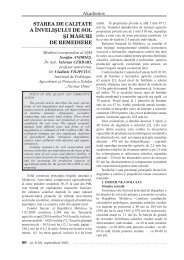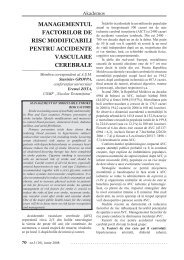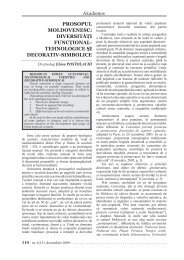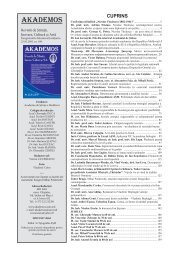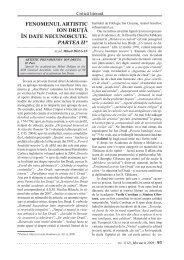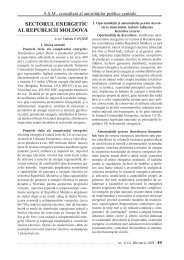Academos 3 2008.indd - Akademos - Academia de ÅtiinÅ£e a Moldovei
Academos 3 2008.indd - Akademos - Academia de ÅtiinÅ£e a Moldovei
Academos 3 2008.indd - Akademos - Academia de ÅtiinÅ£e a Moldovei
Create successful ePaper yourself
Turn your PDF publications into a flip-book with our unique Google optimized e-Paper software.
Repere Zoologie şi obiective<br />
in 10 mM Tris-400 mM NaCl buffer (pH 7.5).<br />
An aliquot of supernatant was used for extraction<br />
of total RNA with a Nucleospin RNA-II kit<br />
(Macherey-Nagel) used according to the supplier’s<br />
recommendations. An average of 2 μg of total RNA<br />
was retrotranscribed at 25°C for 10 min and at 50°C<br />
for 1 h with a Thermoscript RT-PCR kit (Invitrogen)<br />
by using random hexamers.<br />
PCR assays were done as follows. Five<br />
microliters of cDNA (1/10 dilution with water)<br />
was mixed with 2.5 μl of 10× buffer (100 mM<br />
Tris-HCl [pH 9], 500 mM KCl, 15 mM MgCl 2<br />
,<br />
1% Triton X-100, 2 mg of bovine serum albumin<br />
per ml), 0.25 μl of a solution containing each<br />
<strong>de</strong>oxynucleosi<strong>de</strong> triphosphate at a concentration of<br />
20 mM, each primer at a concentration of 0.5 μM,<br />
and 1 U of Taq polymerase (Q-Biogen); the final<br />
volume of the mixture was 25 μl. The mixture was<br />
heated for 2 min at 95°C, and this was followed by<br />
35 amplification cycles (30 s at 95°C, 30 s at 56°C,<br />
and 1 min at 72°C) and then by 7 min at 72°C to<br />
complete the polymerization. PCR products were<br />
analyzed by 1.5% agarose gel electrophoresis<br />
[10].<br />
Results and Discussion<br />
A total of 47 honeybee samples originating<br />
from different parts of Republic of Moldova, were<br />
investigated by RT-PCR for the presence of the six<br />
most important honeybee viruses.<br />
A large majority of the apiaries were found to be<br />
infected by several viruses, as 76% of the apiaries<br />
were found to be positive for at least three different<br />
viruses. As a whole, higher virus frequencies<br />
were <strong>de</strong>tected in adult populations than in brood<br />
populations. In adults during the DWV, SBV,<br />
BQCV, ABPV were found in 62%, 54%, 37% and<br />
10%, respectively. CBPV and KBV viruses were<br />
never <strong>de</strong>tected in bees.<br />
SBV primarily affects the brood of the honeybee<br />
and results in larval <strong>de</strong>ath [7]. Infected larvae fail<br />
to pupate and ecdysis fluid aggregates around the<br />
integument, forming the “sac” for which the disease<br />
is named. Larvae change in color from a pearly<br />
white to pale yellow; after <strong>de</strong>ath, they dry out and<br />
change to a dark brown ship-shaped scab. Infection<br />
of adult bees is possible; the viruses are able to<br />
propagate in them, but the bees remain apparently<br />
healthy. Sacbrood virus appears mainly in spring,<br />
when the brood season begins and large numbers of<br />
infected young adults are present [7].<br />
BQCV is common in adult bees; however, it<br />
clinically affects mainly prepupae or pupae of the<br />
queen, especially in spring and early summer [3].<br />
The symptoms are similar to those of sacbrood.<br />
Infected queen pupae die and darken, and the cell<br />
walls get black.<br />
DWV is mostly <strong>de</strong>tected in Varroa-infected<br />
bees [4, 8]. The virus propagates slowly, and pupae<br />
infected at the white-eye stage of <strong>de</strong>velopment may<br />
have malformed wings. The majority of infected<br />
bees do not show any symptoms.<br />
ABPV commonly appears in apparently healthy<br />
bees; however, it has been presumed that this<br />
virus plays a role in cases of sud<strong>de</strong>n collapse of<br />
honeybee colonies infested with V. <strong>de</strong>structor. Due<br />
to the spread of the varroa mite in Europe during<br />
the last <strong>de</strong>ca<strong>de</strong>s, ABPV has gained more and more<br />
importance [2]. On one hand, the mite is a possible<br />
vector for the virus; on the other hand, it weakens<br />
the bees and activates viral infections [9].<br />
Conclusion<br />
To summarize, we have looked into the<br />
occurrence of the six most important honeybee<br />
viruses in diseased bee colonies and i<strong>de</strong>ntified<br />
remarkable differences in the distribution pattern<br />
of the viruses in the different geographic regions of<br />
Moldova. These differences may be partly explained<br />
by differences in climate, landscape, and <strong>de</strong>nsity of<br />
the bee populations; however, tra<strong>de</strong> and exchange<br />
of infected animals, contaminated equipment, and<br />
bee products between apiaries, regions, or even<br />
countries may be of greater importance in the spread<br />
of viruses.<br />
Acknowledgments<br />
We are greatly in<strong>de</strong>bted to Dr. G. Manic, Dr.<br />
L. Poiras, Mr. A. Zagoreanu and Mr. M. Besliu for<br />
provi<strong>de</strong>d help.<br />
This work was supported by Moldova Aca<strong>de</strong>my<br />
of Scientists.<br />
References<br />
1. Allen, M., and B. V. Ball. The inci<strong>de</strong>nce and world<br />
distribution of honey bee viruses. // Bee World, 1996, Nr.<br />
77. – p. 141-162.<br />
2. Ball, B. V. Varroa and viruses. In P. Munn and<br />
R. Jones (ed.), Varroa! Fight the mite. International Bee<br />
Research Association, Cardiff, Wales, 1997. - p. 11-15..<br />
3. Ball, B. V., and M. Allen. The prevalence of<br />
pathogens in honey bee (Apis mellifera) colonies infested<br />
with the parasitic mite Varroa jacobsoni. // Ann. Appl.<br />
Biol., 1988, Nr.113. – p. 237-244.<br />
4. Bowen-Walker, P. L., S. J. Martin, and A. Gunn.<br />
The transmission of <strong>de</strong>formed wing virus between<br />
honeybees (Apis mellifera L.) by the ectoparasitic mite<br />
nr.3 (10), iunie 2008 - 83



